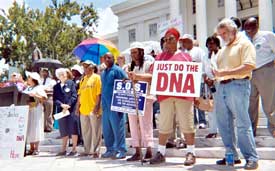An 'unstoppable movement' to end death penalty
By
Minnie Bruce Pratt
Montgomery, Ala.
Published Aug 3, 2007 8:10 PM
Lisa Thomas walked up the steps of the Alabama Capitol Building here on July
25, completing her journey on foot along the historic 1965 civil rights march
route from Selma. Thomas, an anti-hunger activist who runs a food bank in her
hometown of Brewton, Ala., was protesting the imminent execution of Darryl
Grayson.
|
From right: lisa
Thomas (with DNA
sign),
Faya Toure, Rev.
Kenneth Glasgow,
Edward Vaughan,
Esther Brown on
steps
of Alabama
State Capitol.
WW photo: Minnie Bruce Pratt
|
Grayson had been on death row in Alabama for 27 years, longer than all but five
of the 195 men there. Convicted of murder, with allegations of rape, he had
been asking for DNA testing since 2002, saying that in fact because of his
substance abuse he had no memory of committing the crime. The Innocence
Project, a nonprofit organization that represents death row inmates, had also
taken on Grayson’s case.
Thomas was met by a stalwart and diverse crowd of 60 people, including Esther
Brown, executive director of Project Hope to Abolish the Death Penalty in
Alabama.
Brown, who as a young person in Hitler-ruled Berlin was an anti-Nazi activist,
said that Grayson “had gotten Alabama justice for the poor and the
Black” from an all-white jury.
She emphasized that Grayson, an African-American man, was intimidated into
confessing by white police interrogators. (Opelika-Auburn News)
Speakers appealed to Gov. Bob Riley to stay the execution and authorize
administration of a DNA test. They also condemned the extreme inequality in the
Alabama judicial and prison system, which the Rev. Elizabeth O’Neill,
pastor of Immanuel Presbyterian Church, described as a “pipeline between
poverty and prison.”
Alabama is the only state that does not provide an attorney for death row
prisoners following their conviction. It ranks behind every other state in
providing legal aid for low-income or indigent people in non-criminal matters.
Prisoners have sued the state for a wide range of horrendous conditions and
actions including physical torture, overcrowding, lack of treatment for mental
illness, and segregation and medical mistreatment of HIV-positive inmates.
There is also a long history in the state, most notably in the case of the
Scottsboro Brothers in the 1930s, of using accusations of rape to railroad
Black men into the death penalty.
Those gathered at the rally to demand justice for Darryl Grayson included
members of the Grayson family; long-time civil rights activist Alabama State
Sen. Hank Sanders of Selma; Faya Toure, founder of 21st Century Youth; Alabama
NAACP President Edward Vaughan; and former prisoner Rev. Kenneth Glasgow, chair
of the Alabama NAACP Prison Project.
Many attending were part of Alabama Arise, a coalition of over 150 religious,
community and civic groups that fight racism, poverty and the death penalty.
Letters of solidarity were read from the United Methodist Church and from
Hurricane Katrina and Rita survivors now living in Mobile.
On July 26, Grayson was executed by lethal injection. Speakers at the protest
named this killing a “state murder,” and spoke of how during his
time in prison Grayson had become a poet, a journalist and a mentor to others
on death row. Inmates at maximum security Holman Prison in Atmore, where death
row is located, showed their respect and solidarity with Grayson on July 25 and
26 by wearing dress whites and not participating in sports during exercise
yard. (helenl.wordpress.com)
During the rally Diane McNaron, a singer, cultural worker and member of the
Birmingham Peace Project, had affirmed the significance of Grayson’s
life. She spoke of how he represented “other African-American brothers
and sisters who had come through slavery, lynching and segregation” to
launch the 1960s civil rights movement. She said Grayson had taken his place in
that history as part of an “unstoppable movement that will end the death
penalty.”
Articles copyright 1995-2012 Workers World.
Verbatim copying and distribution of this entire article is permitted in any medium without royalty provided this notice is preserved.
Workers World, 55 W. 17 St., NY, NY 10011
Email:
[email protected]
Subscribe
[email protected]
Support independent news
DONATE


